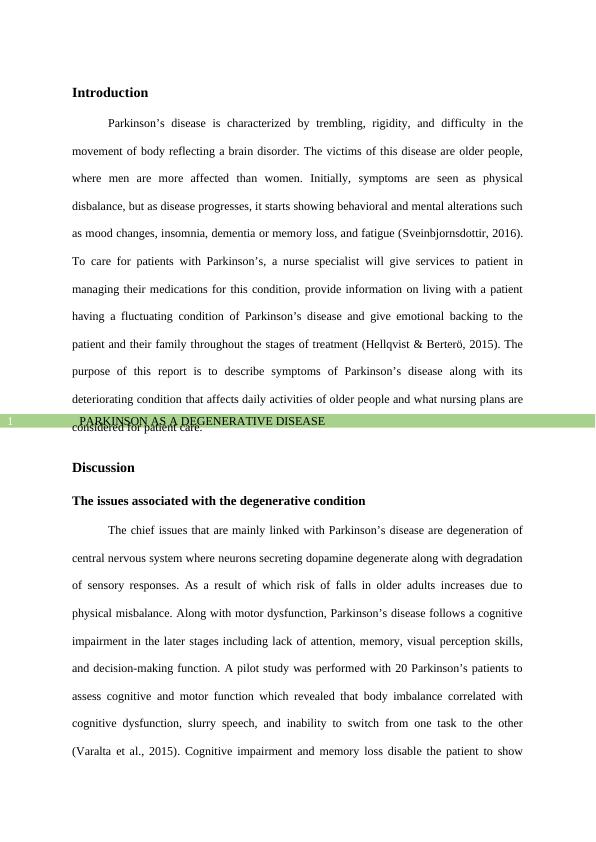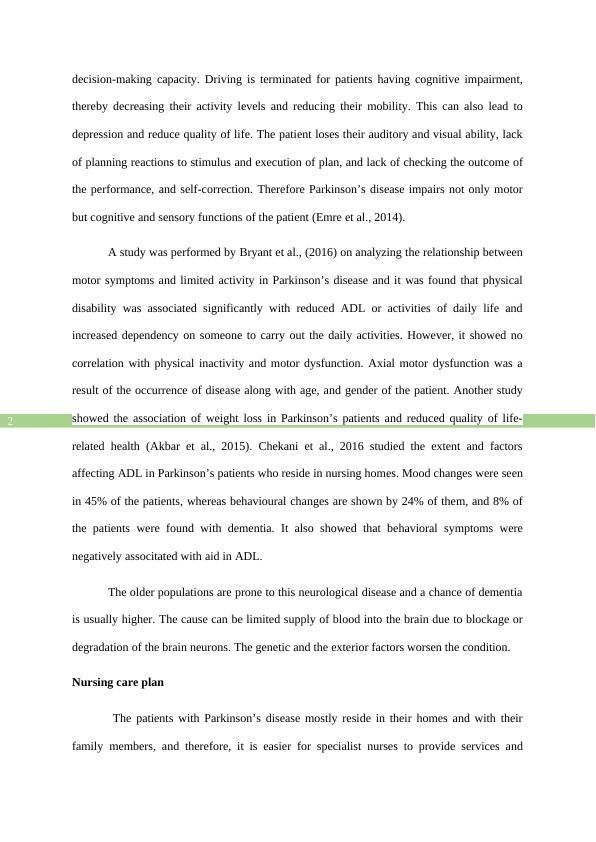Parkinson's disease - Symptoms
Added on 2022-08-22
7 Pages1693 Words23 Views
Running head: PARKINSON AS A DEGENERATIVE DISEASE
Parkinson as a degenerative disease
Name of the Student
Name of the University
Author Note
Parkinson as a degenerative disease
Name of the Student
Name of the University
Author Note

PARKINSON AS A DEGENERATIVE DISEASE1
Introduction
Parkinson’s disease is characterized by trembling, rigidity, and difficulty in the
movement of body reflecting a brain disorder. The victims of this disease are older people,
where men are more affected than women. Initially, symptoms are seen as physical
disbalance, but as disease progresses, it starts showing behavioral and mental alterations such
as mood changes, insomnia, dementia or memory loss, and fatigue (Sveinbjornsdottir, 2016).
To care for patients with Parkinson’s, a nurse specialist will give services to patient in
managing their medications for this condition, provide information on living with a patient
having a fluctuating condition of Parkinson’s disease and give emotional backing to the
patient and their family throughout the stages of treatment (Hellqvist & Berterö, 2015). The
purpose of this report is to describe symptoms of Parkinson’s disease along with its
deteriorating condition that affects daily activities of older people and what nursing plans are
considered for patient care.
Discussion
The issues associated with the degenerative condition
The chief issues that are mainly linked with Parkinson’s disease are degeneration of
central nervous system where neurons secreting dopamine degenerate along with degradation
of sensory responses. As a result of which risk of falls in older adults increases due to
physical misbalance. Along with motor dysfunction, Parkinson’s disease follows a cognitive
impairment in the later stages including lack of attention, memory, visual perception skills,
and decision-making function. A pilot study was performed with 20 Parkinson’s patients to
assess cognitive and motor function which revealed that body imbalance correlated with
cognitive dysfunction, slurry speech, and inability to switch from one task to the other
(Varalta et al., 2015). Cognitive impairment and memory loss disable the patient to show
Introduction
Parkinson’s disease is characterized by trembling, rigidity, and difficulty in the
movement of body reflecting a brain disorder. The victims of this disease are older people,
where men are more affected than women. Initially, symptoms are seen as physical
disbalance, but as disease progresses, it starts showing behavioral and mental alterations such
as mood changes, insomnia, dementia or memory loss, and fatigue (Sveinbjornsdottir, 2016).
To care for patients with Parkinson’s, a nurse specialist will give services to patient in
managing their medications for this condition, provide information on living with a patient
having a fluctuating condition of Parkinson’s disease and give emotional backing to the
patient and their family throughout the stages of treatment (Hellqvist & Berterö, 2015). The
purpose of this report is to describe symptoms of Parkinson’s disease along with its
deteriorating condition that affects daily activities of older people and what nursing plans are
considered for patient care.
Discussion
The issues associated with the degenerative condition
The chief issues that are mainly linked with Parkinson’s disease are degeneration of
central nervous system where neurons secreting dopamine degenerate along with degradation
of sensory responses. As a result of which risk of falls in older adults increases due to
physical misbalance. Along with motor dysfunction, Parkinson’s disease follows a cognitive
impairment in the later stages including lack of attention, memory, visual perception skills,
and decision-making function. A pilot study was performed with 20 Parkinson’s patients to
assess cognitive and motor function which revealed that body imbalance correlated with
cognitive dysfunction, slurry speech, and inability to switch from one task to the other
(Varalta et al., 2015). Cognitive impairment and memory loss disable the patient to show

PARKINSON AS A DEGENERATIVE DISEASE2
decision-making capacity. Driving is terminated for patients having cognitive impairment,
thereby decreasing their activity levels and reducing their mobility. This can also lead to
depression and reduce quality of life. The patient loses their auditory and visual ability, lack
of planning reactions to stimulus and execution of plan, and lack of checking the outcome of
the performance, and self-correction. Therefore Parkinson’s disease impairs not only motor
but cognitive and sensory functions of the patient (Emre et al., 2014).
A study was performed by Bryant et al., (2016) on analyzing the relationship between
motor symptoms and limited activity in Parkinson’s disease and it was found that physical
disability was associated significantly with reduced ADL or activities of daily life and
increased dependency on someone to carry out the daily activities. However, it showed no
correlation with physical inactivity and motor dysfunction. Axial motor dysfunction was a
result of the occurrence of disease along with age, and gender of the patient. Another study
showed the association of weight loss in Parkinson’s patients and reduced quality of life-
related health (Akbar et al., 2015). Chekani et al., 2016 studied the extent and factors
affecting ADL in Parkinson’s patients who reside in nursing homes. Mood changes were seen
in 45% of the patients, whereas behavioural changes are shown by 24% of them, and 8% of
the patients were found with dementia. It also showed that behavioral symptoms were
negatively associtated with aid in ADL.
The older populations are prone to this neurological disease and a chance of dementia
is usually higher. The cause can be limited supply of blood into the brain due to blockage or
degradation of the brain neurons. The genetic and the exterior factors worsen the condition.
Nursing care plan
The patients with Parkinson’s disease mostly reside in their homes and with their
family members, and therefore, it is easier for specialist nurses to provide services and
decision-making capacity. Driving is terminated for patients having cognitive impairment,
thereby decreasing their activity levels and reducing their mobility. This can also lead to
depression and reduce quality of life. The patient loses their auditory and visual ability, lack
of planning reactions to stimulus and execution of plan, and lack of checking the outcome of
the performance, and self-correction. Therefore Parkinson’s disease impairs not only motor
but cognitive and sensory functions of the patient (Emre et al., 2014).
A study was performed by Bryant et al., (2016) on analyzing the relationship between
motor symptoms and limited activity in Parkinson’s disease and it was found that physical
disability was associated significantly with reduced ADL or activities of daily life and
increased dependency on someone to carry out the daily activities. However, it showed no
correlation with physical inactivity and motor dysfunction. Axial motor dysfunction was a
result of the occurrence of disease along with age, and gender of the patient. Another study
showed the association of weight loss in Parkinson’s patients and reduced quality of life-
related health (Akbar et al., 2015). Chekani et al., 2016 studied the extent and factors
affecting ADL in Parkinson’s patients who reside in nursing homes. Mood changes were seen
in 45% of the patients, whereas behavioural changes are shown by 24% of them, and 8% of
the patients were found with dementia. It also showed that behavioral symptoms were
negatively associtated with aid in ADL.
The older populations are prone to this neurological disease and a chance of dementia
is usually higher. The cause can be limited supply of blood into the brain due to blockage or
degradation of the brain neurons. The genetic and the exterior factors worsen the condition.
Nursing care plan
The patients with Parkinson’s disease mostly reside in their homes and with their
family members, and therefore, it is easier for specialist nurses to provide services and

End of preview
Want to access all the pages? Upload your documents or become a member.
Related Documents
Treatment of People with Dementia: Involuntary Movementlg...
|5
|1232
|296
How Effective is Deep Brain Stimulation in Reducing the Symptoms of Parkinson’s Disease?lg...
|7
|1275
|140
The Impact of Living With Parkinson’s Diseaselg...
|8
|2240
|12
Foundations of Nursing Practice | Essaylg...
|6
|1756
|23
Alzheimer’s Disease | Presentationlg...
|1
|1591
|29
Parkinson’s Disease And Dopamine Agonistlg...
|11
|2625
|17
